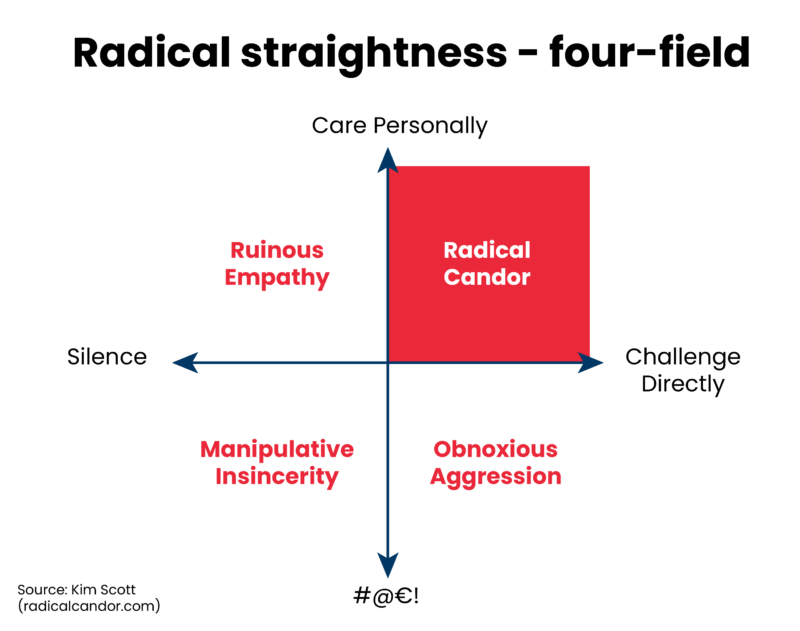Goals are set, although communicated shyly, and there is no courage to follow them openly. Not to mention that underperformance is addressed concretely. The situation of employees is understood and therefore falling short of goals is accepted. And this happens without a clear plan on how the situation could be changed and by when.
Does this sound familiar?
Work-life guru Kim Scott believes that many leadership problems stem from destructive empathy: when supervisors avoid addressing difficult issues, both employees and the company suffer. An article about this in Helsingin Sanomat was revolutionary in its simplicity. Kim Scott has made a classic quadrant of her leadership framework:

Generally speaking, public sector management often falls into the quadrant of destructive empathy. Goals are set, such as the daily amount of direct client work, but it stops there. Personal care, however, is often quite good—at least in psychiatry. The situation of the employees is understood, and therefore falling short of goals is accepted. However, this happens without clear documentation and an action plan on how the situation could be changed and by when.
The Importance of Achieving Goals
In the quadrant of radical candor, there is the courage to demand achieving goals. But at the same time, employees are genuinely and systematically helped. Unclear job descriptions or additional responsibilities that take up work time are addressed. Skills are developed, and expectations are clarified. Often, for example, much more is documented than necessary because employees believe it’s required. Consider whether another task might be more suitable, such as moving from outpatient to inpatient work. And of course, the ability to work is assessed if that is the underlying issue.
We develop a clear monitoring and management system also for personal interaction. Right now, I genuinely believe this is the missing piece needed for effective change management.
The Best and Most Familiar Example of Barriers to Achieving Goals
The best and most familiar example of barriers to achieving goals is probably “all the other work” that takes up time. I must admit, I always thought it was an excuse. When the most common goal is four hours of direct client work per working day, “all the other work” already has half the day reserved—but without investigating, you can’t really know if that’s enough.
Investigating is fundamentally quite simple: provide the employee with a clear view of the goals of client work and their own performance. Require the employee to think about how they can achieve their goals and/or ask their supervisor for help if something clearly prevents them from achieving them. The supervisor is expected to take action and systematically solve the obstacles together with the employee. The implementation of supervisory work should naturally be monitored as clearly as achieving client work goals.
Personal Interaction at the Forefront
Our PIRKKO solution has been excellent from the start in valuing the amount and allocation of work done, transparently and fairly. Simply monitoring the amount of work done without ensuring it is done the right way, at the right time, and with the right patient is at worst harmful – and at best just maximizing pseudo-efficiency. I have long promised myself never to talk only about the amount of client work done. Monitoring and management system for personal interaction quickly leads to an open and appreciative leadership culture where both employees and supervisors thrive.
Kalle Horjamo
CEO
